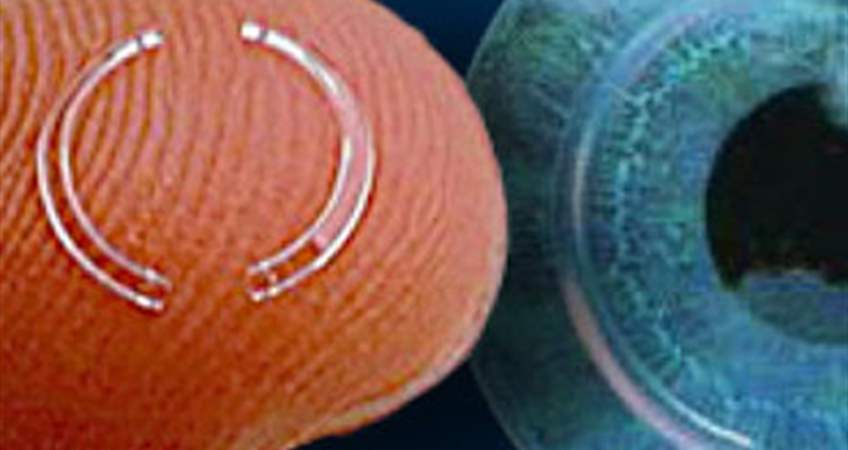Intracorneal ring implantation (INTACS or KeraRing) is an native method for the patients who do not use contact lenses or who have transparent visual axis (without scars). These are consisted of 2 plastic rings which are transparent, intracorneal and lunar. Intracorneal Rings are effective for mild to moderate keratoconus. For this reason, a tunnel is formed within the cornea and then 1 or 2 lunar rings are placed in the tunnel in to flatten the cornea. The tunnel may be formed mechanically or via laser. The process is kept on with an anesthetic drop. Intracorneal Rings reduce the sharpness caused by keratoconus by stretching the cornea.
This process is reversible and the rings can be removed the cornea at any time. It is possible to express the average success rate of intracorneal rings with the “rule of 2”. The rings provide decrease with 2 values, reduction with 2 values and improvement with 2 values in astigmatism, keratometry and uncorrected and the best corrected visual acuity, respectively. The success rates of rings are limited. Therefore, the patients may continue using glasses or hard contact lenses after ring implantation. Sometimes, the patients who can not use hard contact lenses due to the sharpness of keratoconus become suitable for hard lenses after the implantation of these rings. Consequently, although the rule of 2 is considerably successful for the doctors, this ation is sometimes not sufficient for the patients. For instance; a reduction of 2 diopters does not gain favors for a person with 6 diopters astigmatism because the patient still has 4 diopters resulting in insufficient vision. However, this ation is more recognizable for an eye with 3 diopters. Therefore, ring treatment should be applied before keratoplasty or in patients who do not use hard contact lenses provided that keratoconus is nor advanced. Complications are rarely observed due to the fact that femtosecond lasers are used.

An native choice is Phakic IOL (Intraocular Secondary Lens Implantation) implantation in to enhance the vision of patients with High Myopia accompanied by stable keratoconus.
This process is reversible and the rings can be removed the cornea at any time. It is possible to express the average success rate of intracorneal rings with the “rule of 2”. The rings provide decrease with 2 values, reduction with 2 values and improvement with 2 values in astigmatism, keratometry and uncorrected and the best corrected visual acuity, respectively. The success rates of rings are limited. Therefore, the patients may continue using glasses or hard contact lenses after ring implantation. Sometimes, the patients who can not use hard contact lenses due to the sharpness of keratoconus become suitable for hard lenses after the implantation of these rings. Consequently, although the rule of 2 is considerably successful for the doctors, this ation is sometimes not sufficient for the patients. For instance; a reduction of 2 diopters does not gain favors for a person with 6 diopters astigmatism because the patient still has 4 diopters resulting in insufficient vision. However, this ation is more recognizable for an eye with 3 diopters. Therefore, ring treatment should be applied before keratoplasty or in patients who do not use hard contact lenses provided that keratoconus is nor advanced. Complications are rarely observed due to the fact that femtosecond lasers are used.

An native choice is Phakic IOL (Intraocular Secondary Lens Implantation) implantation in to enhance the vision of patients with High Myopia accompanied by stable keratoconus.
 Türkçe
Türkçe English
English
 German
German
 Spanish
Spanish


















